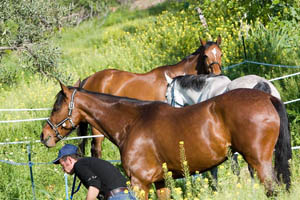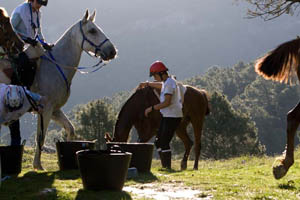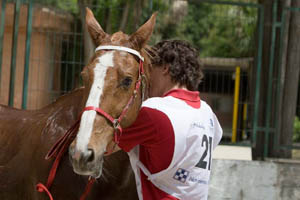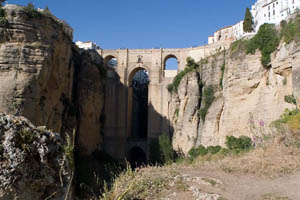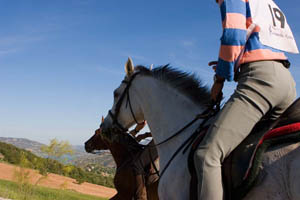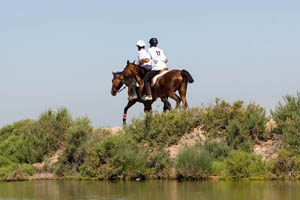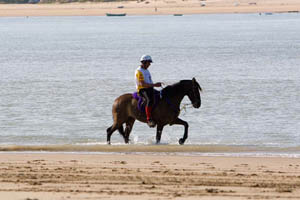
Imagine a competition which is equally a vacation and exploration, amidst the beauty and storied heritage of Andalucía. A point-to-point ride across the breadth of the province, where all stabling, bedding, and forage was ready for your horse at the end of each stage. Where food and drink for riders, crews and staff were amply and deliciously provided, and discounted fine hotel rooms awaited you each night. Where special excursions awaited after the horses were bedded down and all things settled for the morrow. And to turn on the television to find video feeds on the nightly news about the day's results.
That is Tierra del Al Andalus, the brainchild of José Manuel Soto, in its second year, a first class extravaganza for horses and riders, and a showcase for the sport of endurance. A popular singer and television star, Soto is passionate about horses and distance riding, and like those who initiate new rides everywhere, wanted to share the beauty of his home with the world. In our case, that's a ride manager, in this he was the nexus for a first class operation with major sponsors including Kaliber non alcoholic beer, the region of Andalucía, most if not all of the provinces included in the ride, Coca Cola, Purina, as well as some of the resorts which housed the participants, crews and staff.
I kept nearly 5,000 of the 7,000 images I shot, and you'll find 1,100 of them in endurance.net galleries by day. It was an experience I'll never forget, and certainly the everyone who got to be part of this premier event must feel the same.
Here's some of the information and rules the participants followed, though if you like, skip this and go right to the day by day galleries.
Rider entry fees were approximately $1300US if solo ("tandem"), twice that for two riders ("pairs"), two horses, and $2,000 for two horses, one rider ("trio".) That included welcome and farewell dinners, ride meals after each day as well as vet check food for crew as well as riders. Stabling, hay and straw for the horses, special pricing on nearby top hotels, some ride attire, and some of the complementary activities like tours. Conducted under the FEI code of conduct for well-being of the horses, the officials were motivated by completion over the course, urging riders to take into account the varying trail conditions and weather. All riders from outside Spain had to have the permission of their national federations. Horses had to be a minimum of six years old, with passports. Depending on the classification entered, horses had to have done either a CEN one star or CET-P within 24 months of the ride's start. Ride management accredited up to two vehicles per participant.
There were about $1K in prizes each day per 2 divisions, general and for the singles.
Miscellaneous ride rules which overrode the FEI ones if I understood correctly: each day's ride's end was a vet inspection for the next at 7 pm, and a rider meeting at 9. Horses presented at the mid ride vet check had two possible presentations to the vet within 20 minutes of arrival. The heart rate criteria was 56 throughout! 154 lbs was in the rules as the minimum weight carried. Approved helmets were required. Rider bibs were issued and were to be worn over at least a t shirt or polo. No draw reins, no whips and spurs were permitted. A properly fitting saddle was in the requirements, too.
Riders needed to have personal liability insurance, they were not covered by ride insurance!
Horses were inspected before travel home at the end of the ride. The officials did some drug testing along the way as well.
Most days the ride started at 8 am, though that was more complicated by certain locations. Cutoffs at each check and stage were specified ahead of time, but were eliminated during discussion in the first ride meeting. Each night the riders got a spreadsheet with the day's results and standings per division, quite impressive. A rider could be disqualified for not attending more than one of the ride briefings
Terrain varied immensely both within the days and throughout the ride: single track trails, two track cart trails, rural roads, and some paved roads. This time of year, the mountains and valleys are so green, and the flowers were gorgeous, especially the amapola/red poppies and alpine woodland. The participants got detailed guides that that far exceeded any ride maps I've seen in the U.S.
Altitude ranged from sea level to about 6,500 feet-- the Sierra Nevadas. The trail markings were of metal signs, lime or plaster, and riders knew ahead of time how dangerous places were marked. There were designated crew assistance points that had management provided water. Crews could help with mounting, eating, washing horse, shoeing, lytes, etc.
323 miles all together. Shortest day was the last, at 30 miles. Longest was 48 miles on the 5th day. Road control points all manned by civil and state police units and the list provided ahead of time, it's fun to look back on now and remember the rides through town.





